For the first time in our history, societies are becoming increasingly urban. People are flocking to dense metropolitan areas for work and trying to avoid long commutes and small towns.
While creating a more urban society could potentially lead to more people using public transit and sharing resources, it has also led to serious ecological issues. In fact, cities now account for 70% of greenhouse gas emissions, according to the Global Environment Facility (GEF).
With the consequences of urbanization becoming clear, researchers are working hard to find solutions. Well-planned sustainable cities are key to the health of our planet and economic growth. So what can we expect from cities of the future?
Engineering the Cities of the Future
City infrastructure involves countless moving parts. By moving toward smarter, more sustainable options for fixing and upgrading infrastructure components, engineers are beginning to make cities more efficient. On a basic level, many cities are beginning to make use of solar power capture on roadways and using recycled building materials to reduce environmental impact.
Cost is an important factor in creating sustainable cities. Eventually, we may have access to self-healing concrete and other infrastructure upgrades that will reduce the need for repairs. Not only do infrastructure repairs currently come at a high cost, but they also slow down traffic and public transit, further congesting cities.
Civil engineers are experimenting with ways to make cities more efficient. Large-scale 3-D printing is making it cheaper to build certain kinds of equipment and could one day be used to create buildings. Today’s engineers are even making themselves more efficient by turning to advanced software for planning, allowing them to quickly see the pros and cons of different design options and even test them using simulations.
The Internet of Things is proving to be a crucial asset for engineers in solving infrastructure problems in cities. Sensors and other devices can collect valuable information that can then be used in infrastructure planning, traffic regulation, and other aspects of city management.
Planning Sustainability for Society
Large-scale urban sustainability is a monumental task that will take cooperation and extensive planning. The GEF has initiated a global program to tackle various angles of city management that require a sustainable overhaul.
In order to create truly sustainable cities, local leaders will need to facilitate changes in different areas of urban planning, like transportation, sanitation, energy, water, and education. Cities in different areas of the world will face unique challenges, such as water scarcity or frequent natural disasters.
Planning for a sustainable society in the future will require an acknowledgment that our way of life is changing. People will need to be willing to make behavior changes and urban leaders will need to create integrated and holistic urban plans to ensure that changes both promote sustainability and maintain the quality of life for people living in cities.
What Will the Future Look Like for the Disenfranchised?
One challenge facing people in urban areas are housing costs and other factors influencing homelessness. As of January 2017, there were an estimated 553,000 people in the United States who were considered homeless. Individuals experiencing homelessness are vulnerable to environmental extremes, violence, and illness. Today, homeless shelters are the main option for people who have no place to go at night.
But could changes in city planning make a difference in the lives of people who are disenfranchised? As engineers improve 3-D printing and create cheaper, more efficient ways to build, it’s important for urban planners to take homeless individuals into account.
One engineering group is already working on the problem. Their research indicates that simply improving the interior of homeless shelters is one way to help families get back on their feet. Creating welcoming spaces where people can feel comfortable making themselves at home helps to improve well-being and self-esteem. It’s a simple change, but it makes a big difference.
In planning for cities of the future, it’s important for urban leaders to have a plan for protecting our most vulnerable citizens.
Where We Go From Here
While there are lots of exciting developments happening in sustainable urban planning, changes need to occur rapidly on a large scale. Urbanization is already occurring, and the burden on cities that are ill-equipped to handle a large influx of people is becoming obvious.
Sharing information and determining best practices for sustainability will be key to encouraging cities to adopt more efficient, environmentally-friendly practices. It’s a daunting task, but adapting our cities to the needs of an urban-focused population will be key to preserving the planet and keeping citizens happy and healthy.












Read 0 comments and reply